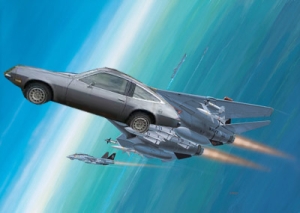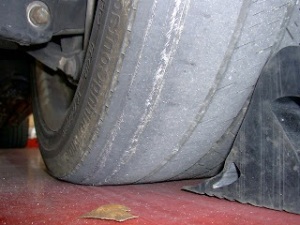Here’s my story it’s sad but true, it’s about a car I once knew. It took my love then ran around, through every light in town…Hayp, Hayp. Bumda hady hady hayp hayp… Well, most of you know the lyrics to the rest of the song. This is the story of a car that was born too soon. If Charles Dickens were to write a story about an orphan car, battered by cruel fate, and then cast aside, he would write about this car. Except, in this story, there is no heroic redemption as in “Great Expectations.” Our story begins in 1969 in the top floors of the GM Building. GM was looking for an alternative power plant to the internal combustion engine that would provide great low-end torque, and a true sporty car feel. NSU, of Germany, had developed a rotary engine, the Wankel engine. Felix Wankel was a brilliant engineer. He was also a high ranking SS officer during WWII. During the war he developed a revolutionary rotary  engine. After doing his prison time following the war, he went to work for NSU Motorenwerke AG. The modern Wankel was shown to the world in 1960. Mazda, seeing its benefits, bought a license to manufacture it. GM saw that Mazda had a hot little number with the technology. In 1970, GM paid NSU $50 million to license the rotary engine. They were going to put it in the Vega. BUT…the GM version had durability problems. They went back to the drawing boards and decided to use it in a model, still in development, to be launched in late 1974. They went back to NSU and paid another $10 million to re-up the license.
engine. After doing his prison time following the war, he went to work for NSU Motorenwerke AG. The modern Wankel was shown to the world in 1960. Mazda, seeing its benefits, bought a license to manufacture it. GM saw that Mazda had a hot little number with the technology. In 1970, GM paid NSU $50 million to license the rotary engine. They were going to put it in the Vega. BUT…the GM version had durability problems. They went back to the drawing boards and decided to use it in a model, still in development, to be launched in late 1974. They went back to NSU and paid another $10 million to re-up the license.
The model in development was a sporty 2+2 hatchback based on a Vega frame. It was going to be called the Chevy Chaparral. Jim Hall Racing of Midland , TX., had long partnered with Chevy to supply him with engines and parts. Chevy made a deal with him to use his Chapparal name. Then, two things happened that would doom the as yet unborn child. GM couldn’t solve the durability problem with the Wankel, and the Arab oil crisis made the Wankel’s mediocre MPG numbers problematic. GM dropped the Wankel. The other was that Jim Hall Racing decided that they wanted more money for their Chapparal name. GM had already spent more than $60 million on an engine they weren’t going to use, they weren’t going to spend more money on a name. Chevy needed a name. And it had to be about 5 inches long, as the dies for the sheet metal forms had already been made. Someone in Chevy Marketing suggested that they let customers name their purchase, providing them with sheets of stick-on letters. That idea died when management begin coming up with some of the possibilities. Then, someone realized that they still held a license for the Monza name. Monza being a trim level name for the ill-fated Chevy Corvair. The unborn child would be christened Monza.
Only one hurdle remained. How would the child be powered? The base engine would be the Vega inline 4-cylinder aluminum block engine. The upgrade would be a V-6 that Buick offered. There was one, teensy, tiny, microscopic, picayune problem with all of this. California, where GM was hoping to repulse the Japanese car invasion, had air quality requirements much more stringent than federal EPA standards. At the time, GM’s solution was to strap on post-combustion air pollution devices. This caused nasty back pressure problems. The Vega for sale in California had a unique problem. They tended to blow up. The aluminum block engine would heat up and expand, causing the cylinders to jam in the combustion chamber, causing the rods to bend and blow. Not good. What about the V-6? Again, Fate had dealt a cruel blow to young Pip. The engine was “dirty” in the state of California, and couldn’t be sold there. What was a mother to do? Again, American ingenuity came to the rescue. A GM engineer had measured the square foot area of the Monza’s engine well. The GM plant in Tonawanda,NY., had excess capacity. They built the monster 5.7 Liter, 350 HP, V-8 engine that went into Corvettes and the Chevy Caprice. The engine developed 250 HP. GM discovered that this engine (clean in California) would fit, just barely, into the Monza engine well. Chevy made it a California-only engine option. There were a few problems to this, however.
where GM was hoping to repulse the Japanese car invasion, had air quality requirements much more stringent than federal EPA standards. At the time, GM’s solution was to strap on post-combustion air pollution devices. This caused nasty back pressure problems. The Vega for sale in California had a unique problem. They tended to blow up. The aluminum block engine would heat up and expand, causing the cylinders to jam in the combustion chamber, causing the rods to bend and blow. Not good. What about the V-6? Again, Fate had dealt a cruel blow to young Pip. The engine was “dirty” in the state of California, and couldn’t be sold there. What was a mother to do? Again, American ingenuity came to the rescue. A GM engineer had measured the square foot area of the Monza’s engine well. The GM plant in Tonawanda,NY., had excess capacity. They built the monster 5.7 Liter, 350 HP, V-8 engine that went into Corvettes and the Chevy Caprice. The engine developed 250 HP. GM discovered that this engine (clean in California) would fit, just barely, into the Monza engine well. Chevy made it a California-only engine option. There were a few problems to this, however.
The Monza had been designed to accommodate a much lighter Wankel engine. It could handle the inline Vega engine, but the huge V-8 weighed hundreds of pounds more than the front end was designed to support. A Monza with the big engine looked like it was always driving downhill, as the weight forced the rear end into the air. This was an engine that was built to power cars weighing almost one ton more than the Monza. Because the car was so much lighter, it was only available with an automatic transmission. Revving it up with a stick, would have torn the gears apart. Being the savvy auto consumer that I was, I bought one!
but the huge V-8 weighed hundreds of pounds more than the front end was designed to support. A Monza with the big engine looked like it was always driving downhill, as the weight forced the rear end into the air. This was an engine that was built to power cars weighing almost one ton more than the Monza. Because the car was so much lighter, it was only available with an automatic transmission. Revving it up with a stick, would have torn the gears apart. Being the savvy auto consumer that I was, I bought one!
What a car!! Pulling up to muscle cars at stop signs, knowing that I had a comparable engine, but weighed as much as a ton less, challenging them off the stop light was child’s play. I didn’t drive this car, I aimed it. Being a rear wheel car with it’s butt up in the air was no handicap. Pushing the accelerator sent 250 horses into the back seat. I was the King of the Road until one day I heard a fwap, fwap, fwap.  The front tire treads had been worn off on the inside, exposing the steel belts. The car had less than 10K miles on it. The Firestone dealer honored the warranty and gave me new tires. Six thousand miles later, the same thing happened. I went to a different Firestone dealer for new tires. I figured out what was going on. Since the front suspension was burdened with hundreds of pounds of extra weight, it sagged and pushed the front tires into a bowed position. I was only driving on the inner six inches of tread! No wonder the tires were failing so quickly. I also discovered that the engine’s radiator, designed to cool a much smaller engine, was the size of a small Frisbee. Another vestige of an earlier incarnation. Maybe Dickens shouldn’t have written the story of the Monza. Maybe Mary Shelley should have.
The front tire treads had been worn off on the inside, exposing the steel belts. The car had less than 10K miles on it. The Firestone dealer honored the warranty and gave me new tires. Six thousand miles later, the same thing happened. I went to a different Firestone dealer for new tires. I figured out what was going on. Since the front suspension was burdened with hundreds of pounds of extra weight, it sagged and pushed the front tires into a bowed position. I was only driving on the inner six inches of tread! No wonder the tires were failing so quickly. I also discovered that the engine’s radiator, designed to cool a much smaller engine, was the size of a small Frisbee. Another vestige of an earlier incarnation. Maybe Dickens shouldn’t have written the story of the Monza. Maybe Mary Shelley should have.
Next: I Visit Sin City

LOVE IT! OF COURE YOU BOUGHT ONE–
MARY